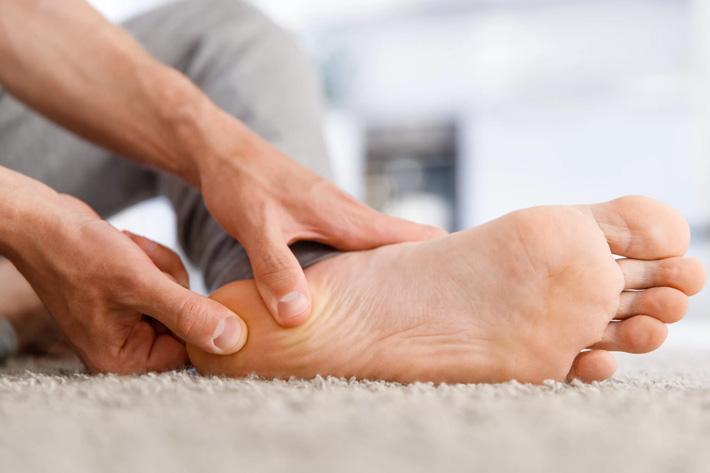Plantar fasciitis is a common foot condition that involves inflammation and irritation of the plantar fascia, a thick band of tissue that runs across the bottom of the foot, connecting the heel bone to the toes. It is typically characterized by heel pain, especially when taking the first steps in the morning or after periods of rest.
Biomechanics plays a significant role in the development and progression of plantar fasciitis. Here’s an overview of the biomechanics involved:
- Foot Pronation: Pronation refers to the natural inward rolling motion of the foot that occurs during walking or running. Excessive or prolonged pronation can put strain on the plantar fascia, leading to its inflammation and subsequent development of plantar fasciitis.
- Abnormal Foot Mechanics: Certain foot abnormalities, such as flat feet (pes planus) or high arches (pes cavus), can alter the distribution of forces during weight-bearing activities. Flat feet can result in excessive pronation, while high arches may lead to reduced shock absorption. Both conditions can contribute to the development of plantar fasciitis.
- Overuse and Repetitive Stress: Activities that involve repetitive impact or excessive loading of the foot, such as running, jumping, or standing for prolonged periods, can strain the plantar fascia. Over time, this can lead to microtears, inflammation, and the onset of plantar fasciitis.
- Improper Footwear: Wearing shoes that lack proper arch support or cushioning can increase the risk of plantar fasciitis. Inadequate support fails to absorb shock effectively, increasing stress on the plantar fascia.
- Tight Calf Muscles: Tightness in the calf muscles, particularly the gastrocnemius and soleus, can affect foot mechanics and contribute to plantar fasciitis. Tight calf muscles limit ankle dorsiflexion, which can increase strain on the plantar fascia during activities that require foot flexion, such as walking or running.
- Biomechanical Compensation: In some cases, plantar fasciitis may develop as a result of compensatory mechanisms. For instance, an injury or pain in another part of the leg or foot may cause altered walking or running patterns, placing abnormal stress on the plantar fascia.
Treatment options for plantar fasciitis focus on relieving pain, reducing inflammation, and promoting healing. Here are some common approaches:
- Rest and Ice: Resting the foot and applying ice packs to the affected area can help reduce pain and inflammation. Ice can be applied for 15-20 minutes several times a day.
- Stretching and Exercises: Specific stretching and strengthening exercises can help alleviate plantar fasciitis symptoms. Calf stretches, towel curls, and toe stretches are often recommended.
- Orthotic Devices: Custom orthotic inserts or over-the-counter arch supports can provide additional support to the foot and help distribute pressure more evenly, reducing strain on the plantar fascia.
- Footwear Modifications: Wearing shoes with good arch support, cushioning, and a proper fit can help relieve symptoms. Avoid high heels and flat shoes with minimal arch support.
- Night Splints: These are devices worn during sleep that stretch the calf and the arch of the foot, helping to keep the plantar fascia stretched and preventing morning pain.
- Nonsteroidal Anti-Inflammatory Drugs (NSAIDs): Over-the-counter pain relievers like ibuprofen or naproxen can help reduce pain and inflammation. However, it’s important to consult a healthcare professional before taking any medication.
- Physical Therapy: A physical therapist can provide targeted treatments, such as ultrasound therapy, massage, and exercises, to alleviate symptoms and improve foot function.
- Extracorporeal Shockwave Therapy (ESWT): This treatment uses shockwave pulses to stimulate healing in the affected area and relieve pain. It’s typically used when other conservative treatments have failed.
- Corticosteroid Injections: In some cases, a healthcare professional may recommend injecting a corticosteroid directly into the affected area to reduce inflammation and pain. However, repeated injections should be avoided due to the risk of tissue damage.
- Surgery: Surgery is typically considered a last resort if all conservative treatments have failed. Minimally invasive/keyhole options such as endoscopic gastrocnemius recession and plantar fascia release have improved plantar fasciitis pain in many.
It’s important to consult with a healthcare professional, such as Dr Ananda for an accurate diagnosis and appropriate treatment plan tailored to your specific condition. We can provide guidance on the most suitable options based on the severity of your plantar fasciitis.





